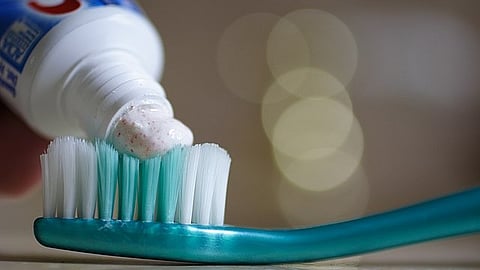Fluoride-free toothpaste:
Fluoride-free toothpaste does not contain fluorides as its active ingredient. These are used in the case of:
Fluoride-free toothpaste contains the following ingredients:
Calcium carbonate or baking soda: These abrasives help in the removal of bacterial stains and plaque
Silica
Xylitol: Natural sweetener that prevents cavities by reducing the growth of bacteria.
Glycerin: Humectant that retains the moisture and texture in the toothpaste
Water: Acts as a base for the toothpaste
Pros of fluoride-free toothpaste:
Avoidance of fluoride overexposure
Individuals with fluorosis or thyroid disorders can opt for fluoride-free toothpaste.
These pastes contain natural ingredients such as essential oils, plant-based abrasives, and herbal extracts.
These pastes can be preferred in individuals who are sensitive to fluorides.
Fluoride-free toothpastes are considered safe for children who are prone to swallowing
Cons of fluoride-free toothpaste:
Reduced protection against caries
Limited effectiveness
Increased risk of cavities
Lack of scientific evidence
Higher cost
Conclusion:
In summary, the decision between fluoride and fluoride-free toothpaste hinges on personal preferences, specific concerns, and individual oral health requirements. Extensively studied and endorsed by dental experts, fluoride toothpaste stands as a scientifically validated solution for combating tooth decay and improving oral well-being. Its efficacy in fortifying tooth enamel and diminishing cavity risk is widely acknowledged, underlining its importance in daily oral care practices.
References:
1. "Fluorides – PubChem Public Chemical Database". The PubChem Project. USA: National Center for Biotechnology Information. Identification.
2. Derakhshani, R; Raoof, A; Mahvi, AH; Chatrouz, H (2020). "Similarities in the Fingerprints of Coal Mining Activities, High Ground Water Fluoride, and Dental Fluorosis in Zarand District, Kerman Province, Iran". Fluoride. 53 (2): 257–267.
3. Derakhshani, R; Tavallaie, M; Malek Mohammad, T; Abbasnejad, A; Haghdoost, A (2014). "Occurrence of fluoride in groundwater of Zarand region, Kerman province, Iran". Fluoride. 47 (2): 133–138.
By Dr. ANJALI KV


